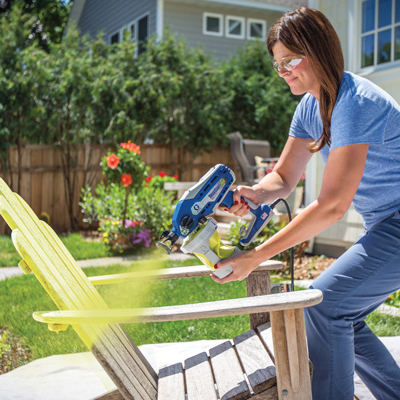How To Paint Outdoor Furniture Using a Paint Sprayer
Project Overview
Whether it’s a flea market find or a special chair you already own, a fresh coat of paint can give new life to outdated or tired-looking furniture.
Safety Notice: Whenever operating spray equipment, take proper safety precautions, stay alert and be mindful of potential hazards. Wear protective gear such as gloves, safety glasses/goggles, spray sock (hood), hat, proper footwear, dust masks and respirators. Make sure there is adequate ventilation. If you’re painting in the vicinity of appliances, turn them off. (See Safety Precautions in your Sprayer Operation Manual.) Always refer to the specific instructions and safety procedures for the spray equipment you are using.

WATCH: How to Spray Furniture (1:00)
Suggested Tools & Equipment
- Graco, Magnum, or TrueCoat Paint Sprayer (visit Paint Sprayer category page to compare models)
- Paint/Stain
- Spray tips – a wider spray pattern for large surfaces and narrow size for smaller surfaces (see tip selector)
- Empty buckets for priming sprayer and clean up (two needed)
- Stirring sticks
- Sandpaper – 100-300 grit
- Tack cloth
- Paint strainer bag – helps prevent tip plugs and provides a better finish
- Tarps, drop cloths, or plastic sheeting
- Masking tape
- Paint brush for touch-ups
- Pump Armor storage fluid (see pump protectant product details)
- Cleaning rags
- Stiff nylon brushes for clean up
Getting Started/Prep
- Establish a work area away from other surfaces onto which overspray could land and cover the grass or pavement of that area with tarps or drop cloths.
- Set the furniture on the drop cloth and remove any hardware.
- Thoroughly clean the furniture using either a scrubbing sponge and a cleaning agent or a pressure washer outfitted with its low-power washing nozzle. Rinse thoroughly and allow to dry.
- Repair any cracks or damage. Fill any holes with putty as needed, and then lightly sand the entire surface. Start with 100-grit sandpaper to remove any loose paint, and increase to 300-grit to smooth the surface and increase paint adhesion. Finally wipe down the furniture piece with a tack cloth to remove any sanding dust.
Spraying
- Select the spray tip that's best suited for the paint or stain you are using and the surface to be sprayed. In general, a tip with a narrower 20 cm wide spray pattern and a .013 hole size will give you the best control. Be sure the tip's hole size does not exceed the maximum capacity of your sprayer (see spray tip info).
- If you're using paint from multiple containers, mix it together in an empty 20 litre container to ensure consistent colour even if small colour differences exist between individual paint cans. When spraying lighter materials like stains, select the lowest pressure setting that enables you to maintain a good spray pattern. Lower pressure settings will give you better control a finer finish.
- Work from the top down, spraying in long, even strokes and going with the grain of the wood. Keep the spray tip about 30 cm from the surface you're spraying. Pay particular attention when spraying into narrow spaces such as between boards and overlap each successive spray pass by approximately 50%.
Clean Up
- Allow significant time for the paint or stain to dry; then remove all coverings from shrubs, bushes, plants and surfaces.
- Replace any hardware that you’ve removed.
- Replace any lighting fixtures that you removed and move furniture or other items back into place.
- Clean your airless paint sprayer after each use. Follow the directions in your user’s manual for Power Flush cleaning with water based materials or use the bucket method of cleaning if applicable. For more information, see Power Flush Video or refer to your Sprayer Operation Manual.
Related Projects
Shutters
With a fresh coat of stain or paint, decorative shutters greatly improve your home's curb appeal while preserving and protecting them from sun and weather damage.
Sheds
Sheds are great for storage. Just like your house, your shed can fade over time. Graco sprayers make it easy to freshen its appearance with a new coat of paint or stain.
Railings
Railings take a lot of abuse. Keep them looking their best with a fresh coat of paint or stain to preserve and protect them from the sun and weather.




